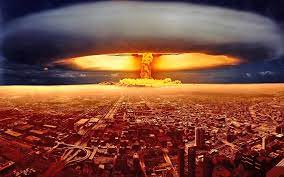Nuclear Bomb Explosion
At present nuclear detonations are the most devastating of the weapons of mass destruction. Depending upon the environment in which the nuclear device is detonated, blast effects are manifested as ground shock, water shock, cratering, and large amounts of dust and radioactive fallout.
The energy of a nuclear explosion is transferred to the surrounding medium in three distinct forms: blast; thermal radiation; and nuclear radiation.
Because of the tremendous amounts of energy liberated per unit mass in a nuclear detonation, temperatures of several tens of million degrees centigrade develop in the immediate area of the detonation. This is in marked contrast to the few thousand degrees of a conventional explosion. At these very high temperatures the non-fissioned parts of the nuclear weapon are vaporized. The atoms do not release the energy as kinetic energy but release it in the form of large amounts of electromagnetic radiation.
In an atmospheric detonation, this electromagnetic radiation, consisting chiefly of soft x-ray, is absorbed within a few meters of the point of detonation by the surrounding atmosphere, heating it to extremely high temperatures and forming a brilliantly hot sphere of air and gaseous weapon residues, the so-called fireball. Immediately upon formation, the fireball begins to grow rapidly and rise like a hot air balloon.
Within a millisecond after detonation, the diameter of the fireball from one megaton (Mt) air burst is 150m. This increases to a maximum of 2200 m within 10 seconds, at which time the fireball is also rising at the rate of 100 m/sec. The initial rapid expansion of the fireball severely compresses the surrounding atmosphere, producing a powerful blast wave.
As it expands toward its maximum diameter, the fireball cools, and after about a minute its temperature has decreased to such an extent that it no longer emits significant amounts of thermal radiation. The combination of the upward movement and the cooling of the fireball gives rise to the formation of the characteristic mushroom-shaped cloud. As the fireball cools, the vaporized materials in it condense to form a cloud of solid particles. Following an air burst, condensed droplets of water give it a typical white cloudlike appearance.
In the case of a surface burst, this cloud will also contain large quantities of dirt and other debris which are vaporized when the fireball touches the earth's surface or are sucked up by the strong updrafts afterwards, giving the cloud a dirty brown appearance. The dirt and debris become contaminated with the radioisotopes generated by the explosion or activated by neutron radiation and fall to earth as fallout.
The relative effects of blast, heat, and nuclear radiation will largely be determined by the altitude at which the weapon is detonated. Nuclear explosions are generally classified as air bursts, surface bursts, subsurface bursts, underwater bursts and high altitude bursts. The most dangerous are underwater and high altitude bursts, although other bursts are pretty dangerous too.
nuclear detonation- ядерный взрыв
devastating - разрушительный
WMD - Weapons of Mass Destruction - ОМП - Оружие массового поражения
blast effect - эффект взрыва
manifested as - проявляется как
ground shock - земной толчок
water shock - водный удар
cratering - кратер
large amounts of dust - большое количество пыли
radioactive fallout - радиоактивные осадки
surrounding medium - окружающая среда
blast - взрыв
thermal radiation - тепловое излучение
nuclear radiation - ядерное излучение
tremendous amounts of energy - огромное количество энергии
energy liberated per unit mass - энергия, выделяемая на единицу массы
centigrade - стоградусный
in the immediate area - в непосредственной близости
marked contrast to - резкий контраст
a conventional explosion - обычный взрыв
the non-fissioned part - неделившаяся часть
vaporized - испарился
kinetic energy - кинетическая энергия
release - высвобождать
electromagnetic radiation - электромагнитное излучение
an atmospheric detonation - атмосферная детонация
soft x-ray - мягкий рентген
absorbed within - поглощен внутри
the point of detonation - точка взрыва
a brilliantly hot sphere of air - ослепительно горячая сфера воздуха
gaseous weapon residues - газообразные остатки оружия
fireball - огненный шар
air burst - воздушный взрыв
rising at the rate of - растет со скоростью
The initial rapid expansion - первоначальное быстрое расширение
severe compress - сильное сжатие
a powerful blast wave - мощная взрывная волна
expand toward - расширяться в сторону
to such an extent - до такой степени
emits significant amounts of thermal radiation - испускает значительное количество теплового излучения
the upward movement - восходящее движение
mushroom-shaped cloud - грибовидное облако
the vaporized materials - испаренные материалы
condense to - конденсироваться
solid particles - твердые частицы
condensed droplets - конденсированные капли
cloudlike appearance - облачный вид
In the case of - в случае
a surface burst - поверхностный (наземный) взрыв
subsurface burst - подземный взрыв
underwater burst - подводный взрыв
high altitude burst - высотный взрыв
updrafts - восходящие потоки
afterwards - впоследствии
contaminated with the radioisotopes - загрязнены радиоизотопами
fallout - осадки (выпадать)
relative effects of blast - последствия взрыва
determined by the altitude - определять высотой




Комментариев нет:
Отправить комментарий